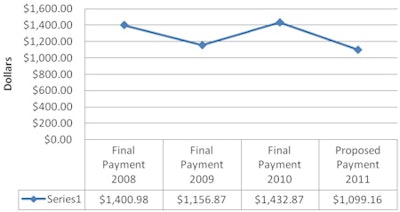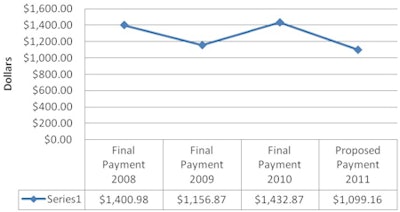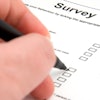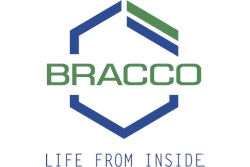
Healthcare facilities and imaging centers in the U.S. struggling with lower reimbursement rates will face another challenge next year, as payments for PET myocardial perfusion imaging will decrease from $1,433 to $1,099.
The U.S. Centers for Medicare and Medicaid Services (CMS) earlier this month announced that it would reduce cardiac PET reimbursement by 23%, effective January 1, 2011, as part of its final rule for the Hospital Outpatient Prospective Payment System (HOPPS). The decrease covers PET myocardial perfusion imaging for metabolic evaluation (CPT code 78459) and single and multiple myocardial perfusion imaging at rest or stress (CPT codes 78491 and 78492, respectively). The 2011 HOPPS final rules can be viewed by clicking here.
CMS based its decision on cost-to-charge ratios (CCRs), and determined that the charges either stayed the same or declined and that the CCRs used to estimate cost from charges for the three CPT codes also declined.
CMS also concluded that the cost of the PET radiotracer rubidium-82 (HCPCS code A9555) decreased. According to CMS, the estimated per-day cost of rubidium-82 as reported in 95% of the claims for multiple myocardial perfusion imaging tests at rest or stress decreased from $418.05 per day in 2010 final rule claims data to $330.06 in the 2011 final rule claims data.
Reduction opposition
As would be expected, advocates for cardiac PET imaging disagree with the new reimbursement rate. Among the objectors is the American Society of Nuclear Cardiology (ASNC), based in Bethesda, MD, which urged CMS in August to develop a methodology for determining myocardial PET payments that would better stabilize reimbursements rates from year to year.
"Of greatest concern to us ... is the fact that this is not the first time payment has fluctuated drastically for myocardial PET within the HOPPS rule," wrote Mylan Cohen, MD, ASNC president. "ASNC is very concerned that such repeated instability in reimbursement for this service makes it impossible for hospitals to plan or budget for the future provision of these services, and may have detrimental results on the use and access of this key diagnostic service for Medicare beneficiaries."
 |
| Cardiac PET HOPPS payments. Chart courtesy of ASNC. |
The communiqué added that the "erratic reimbursement rates for PET are directly related to the low volume of these services and that under the methodology currently employed, where even one practice submits incorrect data, the rates for the service are drastically impacted resulting in a detriment to the entire field."
While the HOPPS formula may work for many procedures, the methodology does not work for cardiac PET payments, according to Kim Williams, MD, past ASNC president and chairman of the division of cardiology at Wayne State University in Detroit.
Breakeven point
Williams gave the example of using a rubidium-82 generator, which he estimated to cost approximately $33,000 to $37,000 per month. "The breakeven point with the current reimbursement is about three patients per day. If you had three patients per day, you are not making any money. If you're doing 10 to 20 patients per day, the cost of the tracer is still fixed and you're able to do this so efficiently that the cost-per-unit per patient dropped tremendously," he explained.
Based on that financial model, Williams, who in the past has served on the CMS' Ambulatory Payment Classification Panel to help determine procedure payments, said a few high-volume imaging centers can markedly affect the median cost of reimbursement, as their per-patient expenses are reduced.
Subsequently, the lower reimbursement will drive smaller imaging facilities out of the market. "This is going to yo-yo until something bad happens," he added. "In this case, people will look at the reimbursement cut and say, 'In this economy, I better not start anything.' "
Accurate recordkeeping
Given that HOPPS payments for cardiac PET are based on data submitted directly by the hospital performing the study, Liz McQuillin, reimbursement manager for Bracco Diagnostics in Princeton, NJ, said it is "critical for hospitals to accurately report costs for performing procedures and to appropriately link the cost center information to the charges."
She added that in the final rule, it is noted that the median charge remained virtually unchanged, while the cost-to-charge ratio applicable to the line item charge for multiple PET myocardial perfusion imaging studies declined from 0.2342 to 0.1708, a decrease of 27%. "When a lower cost-to-charge ratio is multiplied by a hospital's charges, which remain constant, the result is a lower represented cost of the procedure," she added.
Rubidium-82 is marketed under the trade name CardioGen-82 by Bracco and is the most commonly used cardiac PET radiopharmaceutical. In June of this year, Bracco reported that the number of customers using CardioGen-82 had increased by 46% compared to June 2009.
Rubidium-82 market
"PET myocardial perfusion imaging continues to demonstrate significant growth based on the clinical relevance and procedural value of the CardioGen-82 study," said Kim McDaniel, Bracco's director of nuclear medicine sales and market support. "Several considerations include improvements over SPECT in image quality, better diagnostic accuracy, and lower radiation exposure to patients."
As for how the lower reimbursements might affect the cardiac PET market, McDaniel added that the company understands "our customers have invested in cardiac PET myocardial perfusion imaging with CardioGen-82 for the clinical value and for the long-term benefits of adding this modality. Each facility will need to evaluate their costs of providing the service versus their reimbursement for the procedure."
By Wayne Forrest
AuntMinnie.com staff writer
November 26, 2010
Related Reading
CMS posts final MPFS, HOPPS rules for 2011, November 12, 2010
CMS proposes 2.15% increase in HOPPS, July 14, 2010
CMS pitches 90% use rate in proposed 2010 MPFS rule, July 1, 2009
CMS to raise hospital outpatient payments 3%, July 8, 2008
CMS delays Medicare payments due to SGR impasse, July 1, 2008
Copyright © 2010 AuntMinnie.com




















